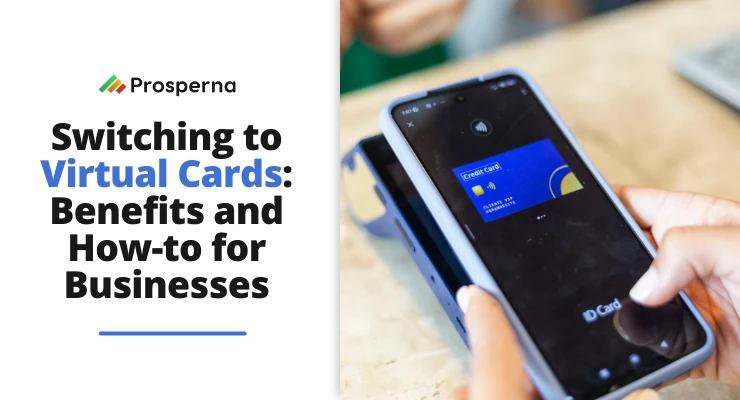Businesses today are constantly seeking innovative ways to streamline their processes and increase efficiency. One area where they can make a significant impact is through their payment systems.
Traditional payment methods, such as paper checks and physical credit cards, can be time-consuming and prone to errors. However, with the rise of digital payment solutions, businesses now have the option to switch to virtual cards, offering a more secure and efficient payment system.
In this blog, we’ll explore the benefits of virtual cards and how businesses can make the switch to a digital payment system.
What Is a Virtual Card?
A virtual card, also known as an e-card, is a digital payment type that enables businesses to make purchases and payments online without the need for a physical card.
They are typically single-use or limited-use cards, meaning that they are generated for a specific transaction or a set of transactions and can only be used for that purpose.
They function similarly to traditional credit cards but without the physical card itself.
Instead, during the online checkout process, virtual cards are represented by a special set of digits that can be supplied manually or automatically.
Are Virtual Cards Safer?
Yes, virtual cards are generally considered safer than traditional credit or debit cards.
This is because virtual cards are not physically present, and they typically have built-in security features that help protect against fraud and unauthorized use.
For example, since they are typically single-use or limited-use cards, the card number becomes useless once the translation is complete.
Plus, the dynamic CVV codes change for each transaction, and spending limits can be set by the cardholder to control expenses.

Advantages of Using Virtual Cards Over Traditional Physical Cards
There are several advantages to using virtual cards over traditional physical cards. Here are some of the most significant benefits:
- Enhanced Security. Virtual cards are considered more secure than physical cards, as they are not susceptible to skimming or cloning. Since virtual cards are often single-use or limited-use, it means that they can be used only for a specific transaction or set of transactions, making them less vulnerable to fraud or unauthorized use.
- Cost-Effective. There are no costs associated with printing and distributing physical cards, which can save businesses money in the long run. Virtual cards can also help businesses track expenses and manage budgets more effectively, leading to greater cost savings over time.
- Greater Control. Businesses can set spending limits and other parameters to manage expenses more effectively. They can also monitor transactions in real time, which allows them to detect and prevent fraudulent transactions.
- Convenience. Since virtual cards are not physical, they can be accessed and used anywhere with an internet connection. This means that businesses can make payments and manage expenses on the go without having to carry around physical cards or be tied to a specific location.
Benefits of Virtual Cards for Businesses in the Philippines
There are many benefits to using virtual cards, including:
1. Improved Security and Fraud Prevention
You can ensure online payment security with virtual cards because they generate a single-use or limited-use card number for each transaction, two-factor authentication, and encryption, reducing the risk of fraud and unauthorized transactions.
In the event of a security breach, users can easily disable the card or generate a new card number, reducing the impact of any potential security breach.
2. Enhanced Control and Flexibility Over Spending
Users can generate virtual cards with specific spending limits or expiration dates. They can also generate virtual cards for specific merchants or online services.
This makes virtual cards ideal for managing corporate expenses or limiting personal spending.
Users can also easily disable or delete virtual cards at any time, giving them the flexibility to manage their accounts and control their spending as needed.
3. Streamlined Payment Processes and Reduced Administrative Burden
With virtual cards, users can generate payment card numbers on demand, eliminating the need for physical cards to be printed and mailed.
This reduces the time and resources required to issue new cards and reduces the administrative burden on card issuers.
They can also be easily integrated into existing accounting and expense management systems, further reducing the administrative burden of managing payments and expenses.
4. Improved Tracking and Reporting of Expenses
Virtual cards can be easily integrated into existing accounting and expense management systems, making it easy to generate reports and analytics on spending activity.
You can easily track and monitor your spending through a centralized dashboard, which provides real-time updates on transaction activity and account balances.
5. Real-Time Visibility for Every Online Purchase
With virtual cards, you can simplify digital payments because users can easily create a new card number for each subscription, ensuring that their personal or business credit card information is not shared with multiple merchants.
This level of control makes virtual cards an ideal solution for managing multiple subscriptions, as users can easily track their spending and avoid any unexpected charges.
6. Real-Time Visibility for Every Online Purchase
Using virtual cards allows one to view the full transaction history and account balances at any time on a single dashboard. This makes it simple to keep track of expenses, keep an eye on account activity, and quickly spot any unapproved or fraudulent transactions.

How to Apply for a Virtual Card
The process of applying for a virtual card can vary depending on the card provider.
However, in general, the following steps may be involved:
- Choose a card provider. There are several virtual card providers to choose from, so you’ll need to research and compare options to find the one that’s right for you. Consider factors such as fees, security features, and ease of use when making your decision.
- Create an account. Once you’ve chosen a card provider, you’ll typically need to create an account on their website or app. This may involve providing personal information, such as your name, address, and contact details.
- Add funds. Next, you’ll need to add funds to your virtual card account. This can typically be done through a bank transfer or credit/debit card payment.
- Generate a card. Once you’ve added funds to your account, you can generate a virtual card. This will typically involve selecting the card type and specifying the amount of the card.
- Use the card. Once you’ve generated your virtual card, you can use it for online purchases or other transactions, just like a traditional physical card.
It’s important to note that the specific steps and requirements for applying for a virtual card may vary depending on the provider. Be sure to read the provider’s terms and conditions carefully before applying, and make sure you understand any fees or charges associated with using the card.
Virtual Cards FAQs
Is a virtual card different from a digital wallet?
Yes, a virtual card is different from a digital wallet. A virtual card is a single-use or limited-use payment card that can be generated on demand and used for a specific transaction or set of transactions. In contrast, a digital wallet is a mobile app or web-based platform that allows users to store, manage, and use various payment methods, including credit/debit cards, bank accounts, and other digital payment options.
Final Thoughts
Virtual cards offer a range of advantages over traditional physical cards, including enhanced security, increased control over spending, and improved convenience. With the rise of online and mobile payments, virtual cards have become an increasingly popular payment method for businesses and individuals alike.
By making the switch to virtual cards, you can enjoy the benefits of a more streamlined and secure payment experience, while also taking advantage of the flexibility and versatility that virtual cards offer. Whether you’re looking to manage corporate expenses more effectively or simply want a safer and more convenient way to make online purchases, virtual cards are a valuable tool that can help you take control of your finances and simplify your payment process.
Prosperna, Your Partner to eCommerce Success
Prosperna is an all-in-one eCommerce platform for Philippine businesses and digital creators. We are on a mission to empower 1 million Filipinos with simple and affordable eCommerce solutions.
In fact, we are super passionate about helping Philippine businesses and digital creators we’re giving you a free account forever!
Want to start selling online? Create your free-forever Prosperna account now.




